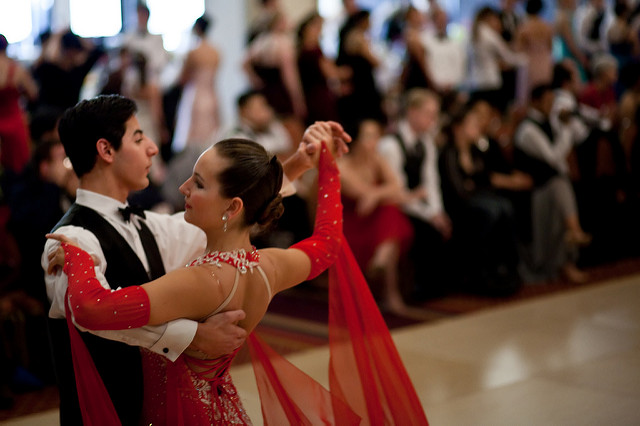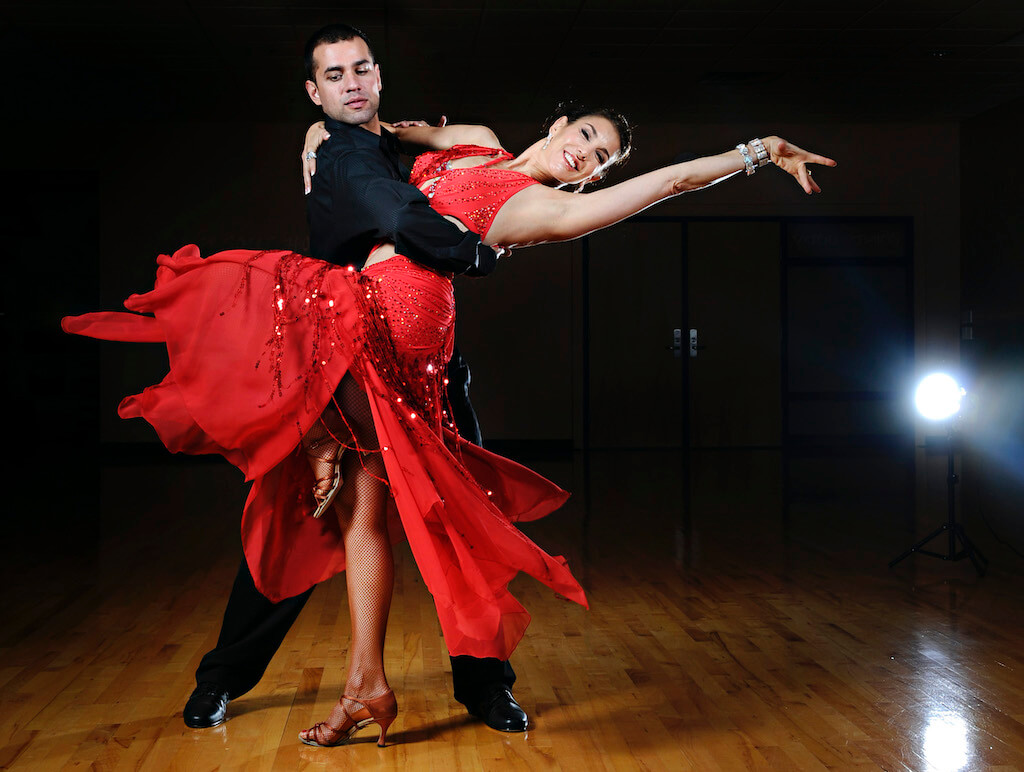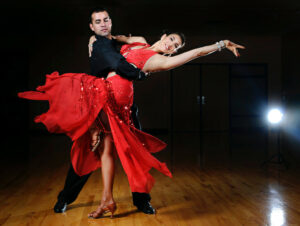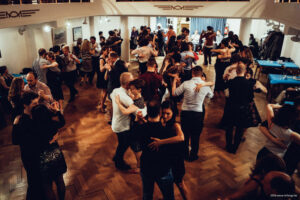SOME HISTORY
Argentine tango originated on the banks of the Rio de la Plata, in Buenos Aires (Argentina) and Montevideo (Uruguay), at the end of the 19th century. The dance and music of black slaves, seasonal workers and immigrants from Europe mingled with that of the gauchos, South American cowboys, who had fled to the city in search of work.
In the early days of the tango (1890 – 1900) it was mainly the men who practiced or invented certain dance steps in what was then called the canyengue. (Immigration meant that there were more men than women at the time.) The accompaniment to music was rather limited: one or two musicians with a guitar, violin or flute.
It was at the beginning of the 20th century that the popularity of the Argentine tango grew. The number of people who started to dance tango grew and there were musical ensembles and large halls in which milongas took place every night. At that time music was always performed live and the music ensemble grew into a full orchestra with several musicians. In the glory years of Argentine tango, the 1930s – 1950s, almost the entire population was dancing tango. The rise of the radio had a major influence on this. Yet it took a long time before the Argentine tango was danced in Europe. Great opposition came from the Church and the medical world. In some circles, tango was considered an ordinary, vulgar dance. Eventually a “clean” form of tango was introduced all over Europe. And so it is that ballroom tango emerged from Argentine tango.
It took until the 1970s before the Argentine tango was danced in its original form in Europe. Today it is one of the most popular dances in this continent and each country has a number of dance schools, milongas, tango festivals and marathons. This creates a kind of “tango tourism”: dancers travel from one country to another to go to milongas. Maestros from Buenos Aires are invited to give performances, shows and workshops, music ensembles appear on the stages of the various cultural centers, etc.
An beautiful example of an Argentine tango show by Roxana Suarez and Sebastian Achaval.
An good example of ballroom tango.
1/ ARGENTINE TANGO
A dance “that moves”
As stated earlier, it was a combination of different styles of music and dance that evolved into what eventually led to the birth of Argentine tango. Argentine tango continues to evolve to this day. So it is a dance that is still not “finished”. Both Argentine tango and ballroom tango are danced a lot in Europe. But it is Argentine tango that is considered to be the original and original dance.
Posture, embrace, abrazo
Typical of the Argentine tango is the closed embrace and the seductive play of the dance partners’ feet and legs. You can dance Argentine tango in both closed and open embrace. The closed embrace or abrazo cerrado is associated with the more traditional style, while the abrazo abierto or open embrace offers more space for the execution of complex figures.
The body position of Argentine tango is completely different from ballroom tango. With Argentine tango, a connection is made in closed embrace. This causes the dance partners’ upper bodies to touch, but the knees and hip joint are further apart. The shape from the outside looks like an inverted letter “∧”. The arms are “carried” from the shoulder joint by the back. The elbows are not next to or behind the body, but rather in front of the hips. The palms of both partners completely encircle each other. There is full contact with a slight compression at the level of the palm of both hands, but without pressure from one partner to the other.
Improvisation
The most important aspect of Argentine tango and with which it completely distances itself from ballroom tango is improvisation. Most other dances have figures for both leader and follower that are performed together in a certain order. It will actually be a predictable dance, a choreography. You should completely ignore that idea when you start Argentine tango.
Argentine tango is a non-verbal dialogue between leader and follower, in which physical communication and body contact between the dance partners play an important role. Argentine tango is leading and following, feeling and responding to movements. And if something goes wrong, if a particular lead does not go as desired, then you improvise as a dance couple together to continue dancing.
Basic elements, not a choreography
Of course it is true that when you start with Argentine tango lessons, figures, structures and postures are learned. Know that each of those learned movements can take a different direction, rhythm, or speed. The steps you are taught serve as a kind of manual in the interaction between the dance partners. Moreover, it is the case that moments of rest or pauses can arise in the dance. That depends entirely on the music you dance to and how the leader interprets that music. It is quite possible that he or she will be inspired to dance to the melody of the song and not, for example, to the beat of the music. That is the choice of the leader. So everything is about feeling and connecting to what your dance partner does. But as a follower you also have a very important role: when the leader takes the time in the music and takes a kind of break, you as a follower can improvise and add an embellishment (also called adorno).
So there are a number of basic elements that you need to master in Argentine tango to be able to dance. On the other hand, it is very nice to know that you can feel free when you will dance it. Unlike ballroom tango, there are no real rules about how to roll the feet and what the correct posture should be. In addition, the embrace is more relaxed and flexible. In this way you develop your own style and you do not have to dance the standardized dance steps, as is the case with ballroom tango. This makes it very difficult to “judge” Argentine tango. Consequently, very few official competitions are organized.
Different styles
As mentioned earlier, Argentine tango has evolved and changed throughout history. As a result, today we can speak about six very distinctive dance styles within Argentine tango. All of them have been very characteristic of the history and evolution of this dance. These include these styles: Canyengue, Orillero, Milonguero, Tango Salon, Tango Fantasia and Tango Nuevo.
In another article on this blog post, we try to explain the characteristics of each of these styles as best we can.
2/ BALLROOM TANGO
Origin
Ballroom tango originated from the Argentine tango, but was introduced in Europe as a polished version. This version was danced less sensually and more stylized. It was its introduction in Hollywood movies that made this dance gain popularity. Under English influence, ballroom tango was standardized and made into a competition dance. Ballroom tango is a style within the five ballroom (standard) dances. Although derived from the Argentine tango and both dances have some similarities, they are different in character as well as in music.
Music
Body position
The body postions and posture of the ballroom tango is also completely different from the Argentine tango. Ballroom tango is danced with slightly bent knees and an open frame in the arms. There is space between the dance partners’ upper bodies. It seems that both partners together form the letter “V”. The lead is given from the hip joint and with a stiff posture in the arms.
The ballroom tango attitude, see: https://en.wikipedia.org/wiki/Ballroom_tango

Two different styles
Ballroom tango split from its original Argentinian roots by allowing European and American influences in the style and performance. In addition, the “Hollywood effect” as well as the competitive aspect had a major influence on the evolution of this dance style. Within the ballroom tango other movements have emerged as a result: “American style” and “International Style”. It is especially this last form, under the influence of the English, that is practiced in a competitive context and worldwide. A handbook with standardized movements, foot and arm techniques, etc. allows a jury to objectively judge the participants and nominate them as champions.
Tango Professional Ballroom Final International Championships 2019 DSI TV
CONCLUSION
The fact is: Argentine tango and ballroom tango are different, but they also have many similarities. They share a similar history, but then parted ways at some point. In both dance styles, you learn figures with a dance partner. One dance style lays down these structures in a kind of manual, ensures that dancing can be done competitively, is stylized and has a different form of music. The other is a complete dance improvisation, with the freedom of choice depending on whether you prefer to dance to the melody or the rhythm of the music. Both these tango forms speak of a certain embrace and body posture, but just in that they are also different. And for both, history and evolution mutually create different other dance styles within their own genre.
Whatever choice you make to learn one or the other tango, prior knowledge of either dance form is not necessarily an advantage.
The experience of BE-TANGO, where only Argentine tango is taught, is that people with ballroom tango experience, are very quick to learn the steps and structures. On the other hand, it takes a lot of training and self-discipline to change the posture and the interpretation of the music, as they were used to from ballroom tango. Moreover, Argentine tango is an improvisation dance, in which none of the learned steps have to be danced in a specific order. In other words: nothing is laid down in a manual, there is only the certainty that one dance partner will lead another across the dance floor. And how he or she does that is entirely his or her choice, with his or her interpretation of the music at that moment.
* * *
Sources:
Wikipedia & Tango info (http://argentijnse-tango.allerbest.nl/).




